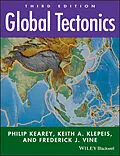- A fully revised third edition of this highly acclaimed text written by eminent authors including one of the pioneers of plate tectonic theory
- Major revisions to this new edition reflect the most significant recent advances in the field, including new and expanded chapters on Precambrian tectonics and the supercontinent cycle and the implications of plate tectonics for environmental change
- Combines a historical approach with process science to provide a careful balance between geological and geophysical material in both continental and oceanic regimes
- Dedicated website available at www.blackwellpublishing.com/kearey/
PHIL KEAREY was Senior Lecturer in Applied Geophysics in the Department of Earth Sciences at Bristol University, U.K. prior to his premature death in 2003. In his research he used various types of geophysical data, but gravity and magnetic data in particular, to elucidate crustal structure in the eastern Caribbean, Canadian shield and southern England.
KEITH KLEPEIS is a Professor in the Department of Geology at the University of Vermont, U.S.A. He specializes in the areas of structural geology and continental tectonics and has worked extensively on the evolution of orogenic belts and fault systems in New Zealand, Patagonia, West Antarctica, Australia, British Columbia and southeast Alaska.
FREDERICK J. VINE is an Emeritus Professor in the School of Environmental Sciences at the University of East Anglia, Norwich, U.K. He was made a Fellow of the Royal Society of London and has received numerous awards for work on the interpretation of oceanic magnetic anomalies and ophiolites, fragments of oceanic crust thrust up on land, in terms of sea floor spreading.
Autorentext
PHIL KEAREY was Senior Lecturer in Applied Geophysics in the Department of Earth Sciences at Bristol University, U.K. prior to his premature death in 2003. In his research he used various types of geophysical data, but gravity and magnetic data in particular, to elucidate crustal structure in the eastern Caribbean, Canadian shield and southern England.
KEITH KLEPEIS is a Professor in the Department of Geology at the University of Vermont, U.S.A. He specializes in the areas of structural geology and continental tectonics and has worked extensively on the evolution of orogenic belts and fault systems in New Zealand, Patagonia, West Antarctica, Australia, British Columbia and southeast Alaska.
FREDERICK J. VINE is an Emeritus Professor in the School of Environmental Sciences at the University of East Anglia, Norwich, U.K. He was made a Fellow of the Royal Society of London and has received numerous awards for work on the interpretation of oceanic magnetic anomalies and ophiolites, fragments of oceanic crust thrust up on land, in terms of sea floor spreading.
Inhalt
Preface ix
Acknowledgments x
The geologic timescale and stratigraphic column xi
1 Historical perspective 1
1.1 Continental drift 2
1.2 Sea floor spreading and the birth of plate tectonics 6
1.3 Geosynclinal theory 7
1.4 Impact of plate tectonics 8
2 The interior of the Earth 9
2.1 Earthquake seismology 10
2.1.1 Introduction 10
2.1.2 Earthquake descriptors 10
2.1.3 Seismic waves 10
2.1.4 Earthquake location 11
2.1.5 Mechanism of earthquakes 12
2.1.6 Focal mechanism solutions of earthquakes 12
2.1.7 Ambiguity in focal mechanism solutions 14
2.1.8 Seismic tomography 17
2.2 Velocity structure of the Earth 19
2.3 Composition of the Earth 21
2.4 The crust 22
2.4.1 The continental crust 22
2.4.2 Upper continental crust 23
2.4.3 Middle and lower continental crust 23
2.4.4 The oceanic crust 24
2.4.5 Oceanic layer 1 24
2.4.6 Oceanic layer 2 25
2.4.7 Oceanic layer 3 26
2.5 Ophiolites 27
2.6 Metamorphism of oceanic crust 28
2.7 Differences between continental and oceanic crust 29
2.8 The mantle 30
2.8.1 Introduction 30
2.8.2 Seismic structure of the mantle 30
2.8.3 Mantle composition 31
2.8.4 The mantle low velocity zone 31
2.8.5 The mantle transition zone 32
2.8.6 The lower mantle 32
2.9 The core 33
2.10 Rheology of the crust and mantle 33
2.10.1 Introduction 33
2.10.2 Brittle deformation 34
2.10.3 Ductile deformation 36
2.10.4 Lithospheric strength profiles 37
2.10.5 Measuring continental deformation 39
2.10.6 Deformation in the mantle 41
2.11 Isostasy 42
2.11.1 Introduction 42
2.11.2 Airy's hypothesis 43
2.11.3 Pratt's hypothesis 43
2.11.4 Flexure of the lithosphere 44
2.11.5 Isostatic rebound 45
2.11.6 Tests of isostasy 46
2.12 Lithosphere and asthenosphere 48
2.13 Terrestrial heat flow 51
3 Continental drift 54
3.1 Introduction 55
3.2 Continental reconstructions 55
3.2.1 Euler's theorem 55
3.2.2 Geometric reconstructions of continents 55
3.2.3 The reconstruction of continents around the Atlantic 56
3.2.4 The reconstruction of Gondwana 57
3.3 Geologic evidence for continental drift 58
3.4 Paleoclimatology 60
3.5 Paleontologic evidence for continental drift 61
3.6 Paleomagnetism 64
3.6.1 Introduction 64
3.6.2 Rock magnetism 64
3.6.3 Natural remanent magnetization 65
3.6.4 The past and present geomagnetic field 66
3.6.5 Apparent polar wander curves 67
3.6.6 Paleogeographic reconstructions based on paleomagnetism 68
4 Sea floor spreading and transform faults 72
4.1 Sea floor spreading 73
4.1.1 Introduction 73
4.1.2 Marine magnetic anomalies 73
4.1.3 Geomagnetic reversals 74
4.1.4 Sea floor spreading 77
4.1.5 The VineMatthews hypothesis 78
4.1.6 Magnetostratigraphy 79
4.1.7 Dating the ocean floor 84
4.2 Transform faults 84
4.2.1 Introduction 84
4.2.2 Ridgeridge transform faults 88
4.2.3 Ridge jumps and transform fault offsets 89
5 The framework of plate tectonics 91
5.1 Plates and plate margins 92
5.2 Distribution of earthquakes 92
5.3 Relative plate motions 94
5.4 Absolute plate motions 97
5.5 Hotspots 99
5.6 True polar wander 103
5.7 Cretaceous superplume 106
5.8 Direct measurement of relative plate motions 107
5.9 Finite plate motions 110
...
